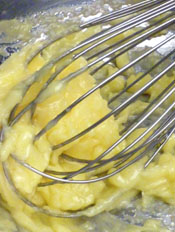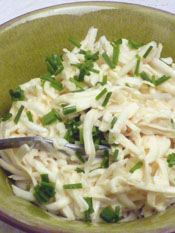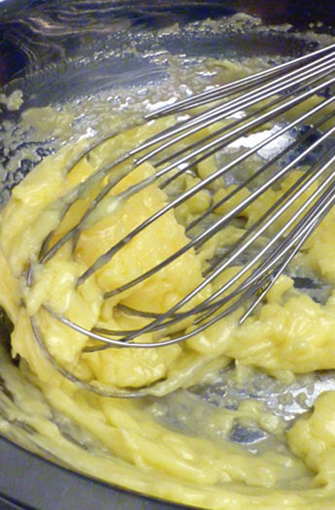Making Mayonnaise
When I attended culinary school I took a three-month course for what were called "serious amateurs," as well as would-be chefs who wanted to try out professional training before making a multi-year-plus-internship commitment. While I was in a kind of cooking school "light," I never felt that my program was dumbed-down: the classes were long and rigorous, our teachers were demanding and exacting, and by the end of the program my pristine chef whites had become irreparably stained, proud evidence of how culinary school is a full body experience. But there was one notable difference: unlike the students in the multi-year professional program, we didn't have final exams.
All the courses took place in kitchen classrooms. Ours was next door to where the professional bread making was taught; most days there would be a small stack of baguettes left on a hallway table (you never starve in culinary school). Further down the hall was the largest classroom, one equipped with not only the usual supply of ovens, sinks and refrigerators but also a grill station and salamanders, those mega-broilers used in restaurant kitchens. This was where the advanced students worked.
One day there was a bit of buzz. Exams were underway and it seemed that an entire class of advanced students had failed their first test: making mayonnaise. My class had just spent the better part of six hours practicing this rich, unctuous, egg-and-oil emulsion that is one of the five "mother" sauces in classic French cuisine. Having eaten Hellman's all my life, suddenly a food I had taken for granted was brand new and had flavor I never knew before. One taste of that thick, pale yellow cream that takes form through the gradual combination of egg yolk and oil makes you appreciate all the fuss.
While mayonnaise isn't difficult to create, it required what our teachers called "technique": it was specific to make. But if the third level students had all failed, it must be difficult, right? Absolutely not. What I came to understand was that making mayonnaise requires patience, not always present in a professional culinary classroom, especially one with a macho grill station. What caused chefs-in-training to stumble is in fact within easy reach for the home cook: you just have to take your time.
So I'm advocating that you learn how to make your own mayonnaise. It is an easy, low-cost way to make ordinary dishes far more special. It can transform chicken salad, make an easy dip for steamed vegetables, or become a complex accent to salmon cakes. Instead of buying mayo as a store-bought processed food, making your own will save money, remove some sugar and preservatives from your diet, and add luxurious flavor to recipes you've been making forever.
Breaking Mayonnaise
Making mayonnaise is simple chemistry: an egg yolk that's been seasoned with a little salt is mixed with a mild-flavored oil until the yolk and oil combine into a creamy emulsion. While not as impossible as oil and water, mixing the yolk and oil isn't instantaneous and it must be done gradually or else the yolk "breaks" -- meaning it gets overwhelmed and disintegrates into curd-like bits so that it no longer combines with the oil. Going back to those failing culinary students, I remember that it was said that every one of them "broke" the yolk by going too fast in the mixing. If you go slowly, mayonnaise is foolproof to make.
While I've tried using either a food processor or blender, I always get the best result by making it by hand. The machines just go too fast and the motor warms the emulsion, which I think disrupts the chemistry. At a time when we're so accustomed to making food fast, mixing mayo means you'll have to set a slow pace: a cup of mayonnaise will take about 5 minutes of hand whisking. Take the time. Get that bicep ready for a work-out. It's worth it.
Making Mayonnaise
You'll need a large whisk, sometimes called a balloon whisk, a medium mixing bowl (I use one of my sturdy stainless steel bowls), and a piece of damp paper towel placed under the bowl so that it doesn't slip and slide against the counter as you mix because you'll need both your hands free.
[It is always important to note that when using raw eggs that anyone who has health concerns should either use pasteurized egg yolks or not make this.]
Have all your ingredients at room temperature and measured out before you begin. This amount makes about 3/4 cup of mayonnaise. If you want to make more you can just double these quantities but remember that it will also take twice the time to mix so get that arm ready to whisk for about 10 minutes.
1 egg yolk (large or extra large)
1/2 teaspoon Dijon mustard
3/4 cup (150 ml) bland vegetable oil; canola is a good choice
1 to 2 teaspoons white wine or Champagne vinegar, or lemon juice
Fine sea salt
Tabasco sauce
- Place the egg yolk in the bowl. Add a pinch of salt and 1/2 teaspoon mustard and use your whisk to break the yolk and combine with the salt and mustard, but don't over mix.
- With the whisk in one hand and the measuring cup of oil in the other, begin adding the oil in a very thin stream -- just barely faster than drop-by-drop. Whisk constantly to combine the yolk with the oil. Start with tiny amounts and as you mix, you will find that you can speed up the rate of adding the oil as the emulsion starts to form, i.e., it starts looking like mayonnaise. It's okay to start and stop when doing this -- add a little oil, then mix, and continue.
- If at any point you seem to have added too much oil or added it faster than the yolk can absorb it, stop adding the oil and keep whisking until it seems well combined. Then start dripping the oil again, always continuing to whisk and only adding as much oil as the yolk can absorb.
- If after adding about half the oil the emulsion seems too thick, you can add a few drops of vinegar or lemon juice to thin the mixture. Then continue to add the oil until it's all combined.
- Taste and adjust the seasoning, adding more salt and vinegar or lemon juice to taste. Instead of using pepper, use drops of Tabasco or another hot sauce to taste so that you won't have little flecks of pepper in your mayonnaise.
You can store your mayonnaise in the refrigerator for up to a week.
Using Homemade Mayonnaise
There's nothing you can do to homemade mayo that you can't do with the one you buy at the grocery store. But because you're starting with something that is so vastly better tasting than the store-bought stuff, every dish you use it in will be notably more delicious because the mayonnaise will actually add flavor and not just oiliness.
Here are some things to do with your own mayonnaise:
- Add a tiny dice of celery, red onion and pickles and toss with good oil-packed canned tuna.
- Add a couple of teaspoons of good balsamic vinegar and mix. Serve as a sauce with roasted chicken.
- Use in your favorite recipes for potato or macaroni salad or cole slaw instead of your usual store-bought mayo. You will be impressed by how better the flavor will be.
- Add extra mustard to your mayo and a generous dice of celery or raw fennel and chopped hard-boiled eggs for a special egg salad. This is a stand-out lunch to take to work.
- Homemade mayo can transform the simplest piece of fish. Add extra lemon and some chopped fresh chives and serve as a sauce with cold poached salmon. A bit of wasabi mustard added to mayo is excellent with a pan-seared tuna steak.
- Major Grey's Chutney and mayonnaise mixed together makes an outstanding chicken salad dressing (use chunks of a store-roasted rotisserie chicken but make sure it's completely cooled before dressing with the mayo).
- For roast turkey leftovers, combine homemade mayo and cranberry sauce and spread on rye bread to make turkey sandwiches.
- Mix mayo with tangy low fat yogurt and hot sauce to serve with crab cakes.
- A little saffron added to mayonnaise makes a lovely sauce for steamed mussels.
Very similar to mayonnaise is aioli, a French sauce that is made with olive oil instead of vegetable oil, plus garlic. In a classic and particularly wonderful Provençal dish, aioli is served with salt cod and boiled vegetables. The stronger the flavor of the olive oil, the stronger the taste of the aioli.
But my favorite thing to do with homemade mayo is make céleri rémoulade.
Céleri Rémoulade
While a classic rémoulade sauce is mayonnaise combined with mustard, capers and a tiny dice of the small French pickles called cornichons, the French salad called céleri rémoulade leaves out the capers and cornichons so that the mustard-mayonnaise dressing is smooth and white on shreds of equally white celery root, which is also called celeriac.
Celery root itself has very little flavor and a faint scent of stalks of celery so its dressing provides much of the salad's taste. The root oxidizes quickly which means it will darken once peeled, which takes away from much of the appeal of this all-white salad. To keep it white, either rub the surface of the peeled celery root with the cut side of a lemon. Alternatively, toss the shreds of peeled and julienned celery root with a teaspoon or so of lemon juice or some of the dressing. Either method will keep it white while you assemble the salad.
A large root will make about 3 cups of céleri rémoulade, which when scooped on a bed of Boston lettuce or spears of Belgian endive, serves 4 nicely as a first course.
1 large or 2 smaller heads of celery root
1/2 cup mayonnaise, preferably homemade
2 to 3 teaspoons Dijon mustard or to taste
Juice of 1/2 large lemon (about 1 tablespoon)
Salt
Tabasco or other hot sauce
- In a small bowl combine the mayonnaise with the mustard and stir well to combine.
- Using a combination of a paring knife and a vegetable peeler, remove the bumpy, sandy outer surface of the celery root until the piece is entirely clean. Rub with some lemon juice so that it doesn't discolor.
- If you have the knife skills and patience, julienne the celery root by hand into long, thin pieces. Alternatively, cut the root into quarters and use the julienne disc of your food processor to entirely shred the pieces.
- Work in small batches and immediately coat the julienned strips with either a teaspoon of lemon juice or a spoonful of the rémoulade dressing to prevent oxidation.
- Combine all the julienned celery root with the dressing and toss to completely coat.
- Taste and adjust seasoning, adding more salt, mustard or hot sauce to your liking.
And What About Hellman's?
Hellman's, or Best's as it's called west of the Rockies, is a great product. I particularly like its Light version, which has half the fat and calories of the full-fat version (35 calories per tablespoon in the Light versus 90 calories in the regular). I'm not such a fan of Hellman's Low Fat; while it has only 15 calories a tablespoon I think its flavor is flat and cloying and not worth even the 15 calories. To me this is an instance of using less of the Light mayo rather than any of the Low Fat.
There are mayo-like products like Miracle Whip that I've always found had a notably artificial flavor and overwhelmed anything that went near it. But a good store-bought mayo like Hellman's can be doctored and added-to just as with your homemade. I always keep a jar in my refrigerator and will add a squirt of Sriracha hot sauce to a cup of Hellman's to serve with oven-roasted potatoes or fish cakes. I also like to combine Hellman's with some ketchup and pickle relish to make Thousand Island Dressing that's great with crudités. And the New Englander in me loves Hellman's with a little added lemon juice and diced celery to make lobster or shrimp salads.
But while Hellman's is a convenient alternative to making your own, the next time the mayo is a key ingredient -- as when you make BLTs with the first summer tomatoes and thick slices of bacon, or you're bringing a curry chicken salad to a friend's potluck birthday dinner -- add the 15 minutes to making your own mayonnaise. I promise you it's worth the trouble and you just might never go back.


